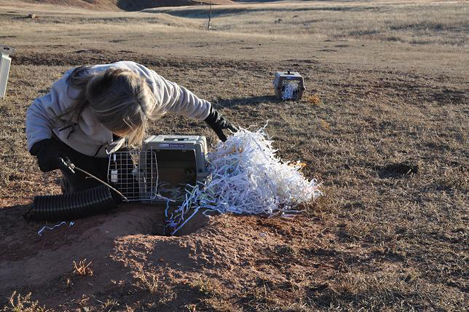44.1: Upeo wa Ekolojia
- Page ID
- 176345
Ujuzi wa Kuendeleza
- Kufafanua mazingira na ngazi nne za utafiti wa mazingira
- Eleza mifano ya njia ambazo ikolojia inahitaji ushirikiano wa taaluma tofauti za kisayansi
- Tofautisha kati ya vipengele vya abiotic na biotic ya mazingira
- Kutambua uhusiano kati ya vipengele vya abiotic na biotic ya mazingira
Ekolojia ni utafiti wa mwingiliano wa viumbe hai na mazingira yao. Lengo moja la msingi la ikolojia ni kuelewa usambazaji na wingi wa vitu vilivyo hai katika mazingira ya kimwili. Kufikia lengo hili kunahitaji ushirikiano wa taaluma za kisayansi ndani na nje ya biolojia, kama vile biokemia, fiziolojia, mageuzi, viumbe hai, biolojia ya molekuli, jiolojia, na hali ya hewa. Baadhi ya utafiti wa kiikolojia unatumika pia mambo ya kemia na fizikia, na mara nyingi hutumia mifano ya hisabati.
Unganisha na Kujifunza

Mabadiliko ya hali ya hewa yanaweza kubadilisha mahali ambapo viumbe huishi, ambayo wakati mwingine inaweza kuathiri moja kwa moja afya ya binadamu. Tazama video ya PBS “Kuhisi Athari za Mabadiliko ya Tabianchi” ambapo watafiti hugundua viumbe vya pathogenic wanaoishi mbali nje ya aina yake ya kawaida.
Viwango vya utafiti wa mazingira
Wakati nidhamu kama vile biolojia inasomwa, mara nyingi husaidia kuigawanya katika maeneo madogo, yanayohusiana. Kwa mfano, wanabiolojia kiini nia ya kiini kuashiria haja ya kuelewa kemia ya molekuli signal (ambayo kwa kawaida ni protini) pamoja na matokeo ya kiini kuashiria. Wanaikolojia wanaovutiwa na mambo yanayoathiri maisha ya aina zilizohatarishwa wanaweza kutumia mifano ya hisabati kutabiri jinsi juhudi za uhifadhi wa sasa zinaathiri viumbe walio hatarini. Ili kuzalisha seti ya sauti ya chaguzi za usimamizi, mwanabiolojia wa uhifadhi anahitaji kukusanya data sahihi, ikiwa ni pamoja na ukubwa wa sasa wa idadi ya watu, mambo yanayoathiri uzazi (kama vile physiolojia na tabia), mahitaji ya makazi (kama vile mimea na udongo), na mvuto wa binadamu unaoweza kuathiriwa na idadi ya watu waliohatarishwa na makazi yake (ambayo inaweza kuwa inayotokana na masomo katika sosholojia na ikolojia ya miji). Ndani ya nidhamu ya ikolojia, watafiti kazi katika ngazi nne maalum, wakati mwingine discretely na wakati mwingine na mwingiliano: viumbe, idadi ya watu, jamii, na mazingira (Kielelezo\(\PageIndex{1}\)).

Organismal Ecology
Researchers studying ecology at the organismal level are interested in the adaptations that enable individuals to live in specific habitats. These adaptations can be morphological, physiological, and behavioral. For instance, the Karner blue butterfly (Lycaeides melissa samuelis) (Figure \(\PageIndex{2}\)) is considered a specialist because the females preferentially oviposit (that is, lay eggs) on wild lupine. This preferential adaptation means that the Karner blue butterfly is highly dependent on the presence of wild lupine plants for its continued survival.

After hatching, the larval caterpillars emerge and spend four to six weeks feeding solely on wild lupine (Figure \(\PageIndex{3}\)). The caterpillars pupate (undergo metamorphosis) and emerge as butterflies after about four weeks. The adult butterflies feed on the nectar of flowers of wild lupine and other plant species. A researcher interested in studying Karner blue butterflies at the organismal level might, in addition to asking questions about egg laying, ask questions about the butterflies’ preferred temperature (a physiological question) or the behavior of the caterpillars when they are at different larval stages (a behavioral question).

Population Ecology
A population is a group of interbreeding organisms that are members of the same species living in the same area at the same time. (Organisms that are all members of the same species are called conspecifics.) A population is identified, in part, by where it lives, and its area of population may have natural or artificial boundaries: natural boundaries might be rivers, mountains, or deserts, while examples of artificial boundaries include mowed grass, manmade structures, or roads. The study of population ecology focuses on the number of individuals in an area and how and why population size changes over time. Population ecologists are particularly interested in counting the Karner blue butterfly, for example, because it is classified as federally endangered. However, the distribution and density of this species is highly influenced by the distribution and abundance of wild lupine. Researchers might ask questions about the factors leading to the decline of wild lupine and how these affect Karner blue butterflies. For example, ecologists know that wild lupine thrives in open areas where trees and shrubs are largely absent. In natural settings, intermittent wildfires regularly remove trees and shrubs, helping to maintain the open areas that wild lupine requires. Mathematical models can be used to understand how wildfire suppression by humans has led to the decline of this important plant for the Karner blue butterfly.
Community Ecology
A biological community consists of the different species within an area, typically a three-dimensional space, and the interactions within and among these species. Community ecologists are interested in the processes driving these interactions and their consequences. Questions about conspecific interactions often focus on competition among members of the same species for a limited resource. Ecologists also study interactions among various species; members of different species are called heterospecifics. Examples of heterospecific interactions include predation, parasitism, herbivory, competition, and pollination. These interactions can have regulating effects on population sizes and can impact ecological and evolutionary processes affecting diversity.
For example, Karner blue butterfly larvae form mutualistic relationships with ants. Mutualism is a form of a long-term relationship that has coevolved between two species and from which each species benefits. For mutualism to exist between individual organisms, each species must receive some benefit from the other as a consequence of the relationship. Researchers have shown that there is an increase in the probability of survival when Karner blue butterfly larvae (caterpillars) are tended by ants. This might be because the larvae spend less time in each life stage when tended by ants, which provides an advantage for the larvae. Meanwhile, the Karner blue butterfly larvae secrete a carbohydrate-rich substance that is an important energy source for the ants. Both the Karner blue larvae and the ants benefit from their interaction.
Ecosystem Ecology
Ecosystem ecology is an extension of organismal, population, and community ecology. The ecosystem is composed of all the biotic components (living things) in an area along with the abiotic components (non-living things) of that area. Some of the abiotic components include air, water, and soil. Ecosystem biologists ask questions about how nutrients and energy are stored and how they move among organisms and the surrounding atmosphere, soil, and water.
The Karner blue butterflies and the wild lupine live in an oak-pine barren habitat. This habitat is characterized by natural disturbance and nutrient-poor soils that are low in nitrogen. The availability of nutrients is an important factor in the distribution of the plants that live in this habitat. Researchers interested in ecosystem ecology could ask questions about the importance of limited resources and the movement of resources, such as nutrients, though the biotic and abiotic portions of the ecosystem.
Career Connection: Ecologist
A career in ecology contributes to many facets of human society. Understanding ecological issues can help society meet the basic human needs of food, shelter, and health care. Ecologists can conduct their research in the laboratory and outside in natural environments (Figure \(\PageIndex{4}\)). These natural environments can be as close to home as the stream running through your campus or as far away as the hydrothermal vents at the bottom of the Pacific Ocean. Ecologists manage natural resources such as white-tailed deer populations (Odocoileus virginianus) for hunting or aspen (Populus spp.) timber stands for paper production. Ecologists also work as educators who teach children and adults at various institutions including universities, high schools, museums, and nature centers. Ecologists may also work in advisory positions assisting local, state, and federal policymakers to develop laws that are ecologically sound, or they may develop those policies and legislation themselves. To become an ecologist requires an undergraduate degree, usually in a natural science. The undergraduate degree is often followed by specialized training or an advanced degree, depending on the area of ecology selected. Ecologists should also have a broad background in the physical sciences, as well as a sound foundation in mathematics and statistics.

Link to Learning

Tembelea tovuti hii ili kuona Stephen Wing, mwanaikolojia wa baharini kutoka Chuo Kikuu cha Otago, kujadili jukumu la mwanaikolojia na aina ya masuala ya mazingira kuchunguza.
Muhtasari
Ekolojia ni utafiti wa mwingiliano wa vitu vilivyo hai na mazingira yao. Wanaikolojia huuliza maswali katika ngazi nne za shirika la kibiolojia-viumbe, idadi ya watu, jamii, na mazingira. Katika ngazi ya viumbe, wanaikolojia hujifunza viumbe binafsi na jinsi wanavyoingiliana na mazingira yao. Katika viwango vya idadi ya watu na jamii, wanaikolojia wanachunguza, kwa mtiririko huo, jinsi idadi ya viumbe inavyobadilika baada ya muda na njia ambazo idadi hiyo ya watu huingiliana na spishi nyingine katika jamii. Wanaikolojia wanaojifunza mazingira huchunguza aina hai (vipengele vya kibiotiki) vya mazingira pamoja na sehemu zisizo hai (vipengele vya abiotiki), kama vile hewa, maji, na udongo, wa mazingira.
faharasa
- sio hai
- sehemu zisizo hai za mazingira
- ya viumbe-hai
- vipengele hai vya mazingira
- maalum
- watu ambao ni wanachama wa aina moja
- ikolojia
- utafiti wa mwingiliano kati ya vitu vilivyo hai na mazingira yao
- tofauti maalum
- watu ambao ni wanachama wa aina mbalimbali


